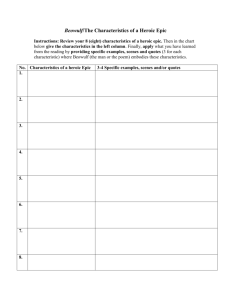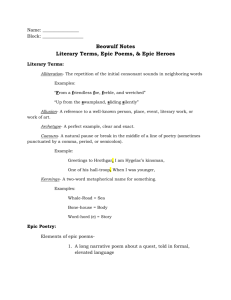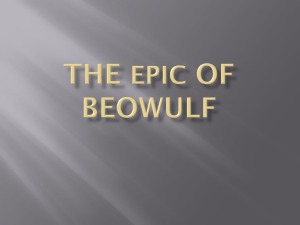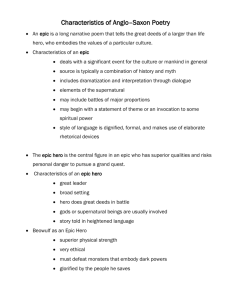BEOWULF EPIC NOTES
advertisement
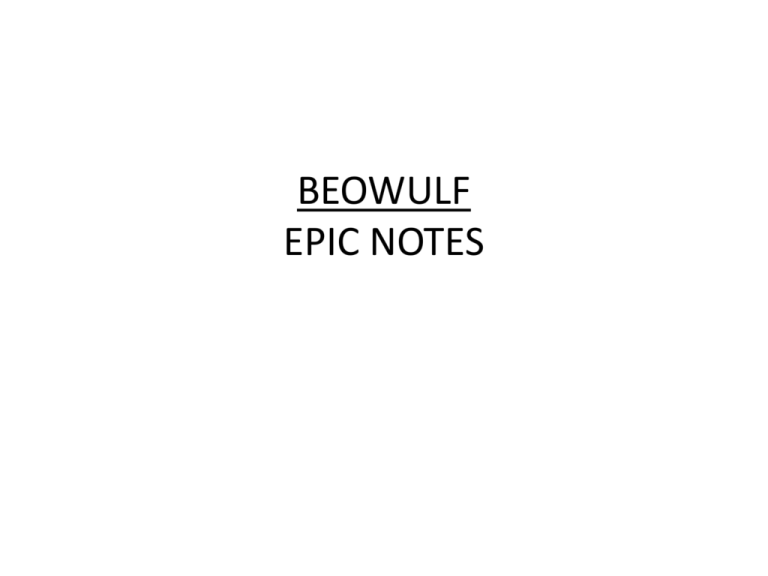
BEOWULF EPIC NOTES AN EPIC IS: pg.1 • sometimes called a heroic poem. • a long narrative poem about the adventures of larger-than-life characters. • sometimes called a literary epic. EPIC HEROES TEND TO HAVE THESE CHARACTERISTICS pg.2 • The hero is a great leader strongly identified with a particular people or society. • The setting is broad and often includes the upper and lower worlds. • The hero does great deeds in battle or undertakes an extraordinary journey. • Sometimes the gods or other supernatural or fantastic beings take part in the action. • The story is told in heightened language. THE THEME OF BEOWULF pg.3 • Heroic Deeds: A way to Immortality – The recounting of heroic deeds is a major feature of Anglo-Saxon literature. The ancient heroes quested to overcome evil, even loneliness, and by so doing, they hoped to win a place in the memory of their people. THE EPIC FORM OF BEOWULF pg. 4 EPIC – a long narrative giving the story of heroic deeds accomplished by a hero of above-average strength and ability. 1. Hero undergoes perilous adventures for the sake of the tribe or nation. 2. Sometimes the hero accomplishes his task with little assistance. (other times the gods may intervene) 3. Comes from oral tradition of history 4. Classical epic opens with invocation to the Muse of epic poetry. -followed immediately by a crucial moment of action. (in medias res, in the middle of) 5. Also has flash backs, repetitions, catalogues, stock phrases, epithets, hospitality codes, epic boasting , intervention of gods and also visits to Hades. THE HERO pg. 5 • The concept of the hero comes out of epic poetry in which historical, geographical, and spiritual elements are incorporated to make the adventure significant enough to carry moral truth. • Beowulf represents both himself, as one who seeks immortality through fame, and the tribal group. He may die, but the group will be saved; his honor is preserved, and that honor strengthens the people. Because of these qualities, he draws followers naturally. • The stature of the hero is frequently measured by the formidable qualities of his adversary. The monster can be analogous to Cain and the serpent, animal and spirit, as well as other forms of evil incarnate with the hero as its antithesis. Epic Elements pg. 6 • • • • • • 1. Address to the Muse (Invocation) (prayer) 2. Conflict 3. Beginning (In media res) (In the middle of) 4. Flashback 5. Return to present 6. Repetitions EPIC ELEMENTS CONT. pg.6 cont. • 7. Catalogues (long lists – the poet would devise long lists of famous princes, aristocrats, warriors and mythic heroes to be lined up in battle and slaughtered) • 8. Stock phrases • 9. Epithets (Short nickname like – fleet-footed Achilles or grey-eyed Athena) • 10. Hospitality Code • 11. Epic boasting • 12. Intervention of gods (Supernatural) • 13. Visit to Hades • 14. Affects entire nation • 15. Vast setting • 16. Narrative format MONSTER QUALITIES pg. 7 • • • • • • • • 1. cruel 2. alien 3. uses magic 4. strange dwelling/home 5. unnatural strength 6. beast-like 7. no values/morality 8. alone/alienated HERO QUALITIES pg. 8 • • • • • • • • • • 1. leadership 2. sincerity 3. courage 4. warrior 5. strength 6. fearlessness 7. modesty 8. honor 9. self-sacrifice 10. concern for the group BEOWULF LITERARY TERMS pg. 9 • 1. caesura - \si zhoor’ e\ - n. a pause or break in a line of verse. • 2. kenning – metaphorical compound words or phrases that indicate a person or thing by a characteristic or quality (ex/ ring-giver=king) • 3. alliteration – the repetition of the same initial letter, sound or group of sounds in a series of words. • 4. personification – giving animate characteristics to an inanimate object TIMELINE pg. 10 HISTORY DATE Stonehenge 2000 B.C. Celts arrive in England 1500-1000 B.C. Roman occupation 55 B.C. – 410 A.D. LITERATURE Jutes, Angles, Saxons arrive 450 A.D. Christian revival 597 A.D. Historical King Arthur in Celtic Wales 500 -600 A.D. 707 A.D. Danish (Viking) raids 787 A.D. The Battle of Hastings 1066 A.D. Beowulf written
